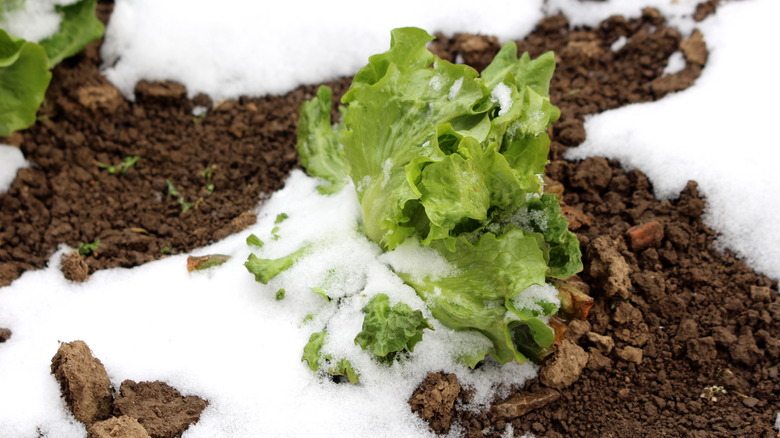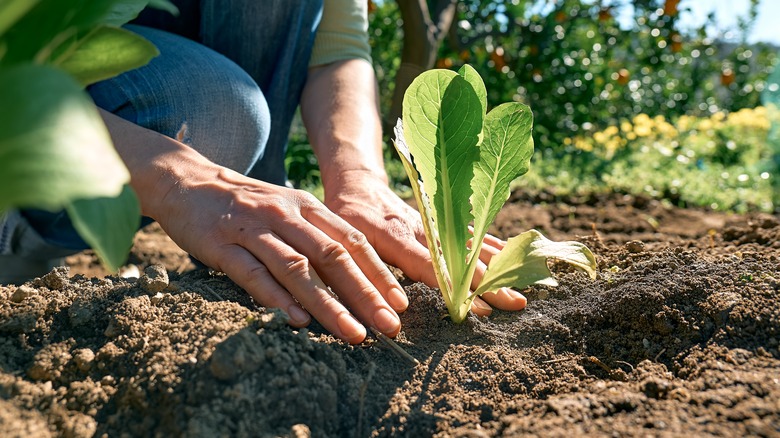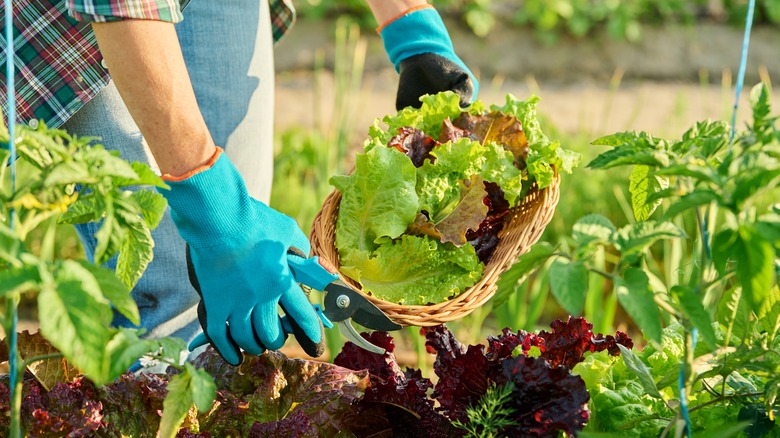How To Successfully Grow And Protect Lettuce Throughout The Winter
We may receive a commission on purchases made from links.
As cooler temperatures settle in, you might think it's the end of your vegetable garden – no more fresh veggies until spring. But did you know that lettuce can grow and thrive in cooler fall temps? With the right techniques, like planting when the soil is warm and protecting them through bouts of serious cold, you might be harvesting fresh leaves for your salads into winter.
If you want to extend the life of your vegetable garden, then look to lettuce, the surprisingly cold-tolerant vegetable. Many varieties of lettuce take on light frost, including temperatures that dip to 28 degrees. There's actually a variety, 'Winter Marvel,' which can even tolerate temperatures as low as 6 degrees if it's provided the proper insulation! Now, that's some hardy lettuce. While you might assume cold weather can make lettuce bitter, that's not true at all. It's the heat and photoperiod, or duration of light, in the summer that makes lettuce bolt. Bolting means that it flowers early and turns bitter, attempting to make seeds instead. Lettuce tends to taste better when grown in cooler weather.
That's why fall might be the perfect time to grow it. The soil might still be warm enough to germinate seeds, and you can harvest young leaves before the true cold sets in. Aim for varieties like leaf lettuce, including butterhead or romaine. These semi-hardy annual vegetables grow above ground, so you can harvest baby lettuce the minute it grows large enough for a salad bowl. Planting heads of lettuce, like traditional iceberg, is doable, but you'll have to time it right to get mature lettuce before winter.
Planting lettuce seeds is easier than you think
If you want to try your hand at growing fall or winter lettuce, then plan to plant your lettuce seeds about a month to six weeks before the first frost. That translates to late summer or early fall for most regions of the country. You'll be surprised how easy it can be when you use a broadcast sowing method. Just sprinkle seeds out where you want them to go and dust them with a thin layer of compost. Try growing heads of lettuce alongside leaf lettuce for variety, both in your garden and in your dinner salads.
Know that lettuce does fine in partial shade, but it doesn't mind a dose of full sun in the cooler fall months. If you're wondering how long it takes for lettuce seedlings to sprout, count on about a week or so. Once lettuce begins to grow and plants start to crowd one another, you might need to thin out the sprouts. Many lettuce varieties might need about 6 inches of space between them, give or take. Wait until they're a couple of inches tall first before thinning. This way, you can thin out punier-looking plants and leave the more robust ones.
Don't throw out the sprouts, though. These very young greens can be tossed in salads, too. Remember that lettuce often will mature in just 40 days, but you'll also have many opportunities to pick young leaves before maturity and enjoy them as garnishes to sandwiches. If you have enough capacity to multitask, you can get healthier soil for spring by planting this vegetable in the fall, along with your lettuce.
Harvest lettuce into the winter
In the "cut and come again" method, you can harvest lettuce when it's between 6 and 10 inches tall. Just slice at the base with a pair of garden scissors. If you keep watering the remaining plant, then you might find new lettuce ready to be harvested in a couple of weeks.
When pulling up weeds around lettuce, be careful. Lettuce roots tend to be shallow, so you don't want to accidentally pull out the whole plant with the intruder. Also, while lettuce can be cold-hardy and tolerate light frost, it may fall prey to extreme dips in the temperature and might need a little extra care to help make it through colder bouts of fall or early winter weather.
Draping row covers or cloth on frames, like the Valibe freeze protection floating row cover, might be a good idea to help give lettuce a little extra insulation once the weather seriously begins to get cold. You can also use burlap or even paper cups turned upside down to protect younger plants from serious frost. Think about adding these protections if the cold weather will last for a bit of time or temperatures plunge to serious lows. With a little help, lettuce might last long into winter. Some varieties of young lettuce sprouts might even survive the winter and grow in the spring. 'Winter Marvel,' 'Winter Density,' and 'Arctic King' are such hardy varieties, they've sometimes been known to outlast the coldest months.


